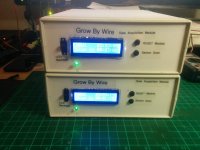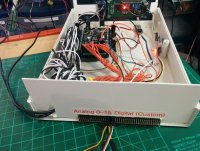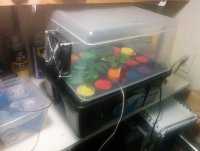- Thread starter
- #21
odam2k
Well-Known Member
Quick update, the new "Module" prototype is complete, at least hardware wise I think.
Each "Module" supports 16 analog sensors plus about 50 digital. The code has been updated to support Relays on the digital pins, along with some coding to allow you to assign a sensor to a relay and use it to drive it. For example, I put a humidity dome on my DWV Cloner (I know, everyone says DON'T) because the humidity has been so low, about 20-25%. Of course, with the dome, the humidity under it was 100%, too much... I cut a small hole in the dome, and mounted a muffin fan, like you find in a PC. The fan comes on when the humidity reaches a certain level, and goes off when it falls below a certain level. So far, it';s working great, although it moves so much air it doesn't stay on. I may try to find a smaller fan for it.
Here are the new design modules, so much neater!

And the back, with the Analog and Digital ports...

and finally, the Humidity Dome with the muffin fan...

Each "Module" supports 16 analog sensors plus about 50 digital. The code has been updated to support Relays on the digital pins, along with some coding to allow you to assign a sensor to a relay and use it to drive it. For example, I put a humidity dome on my DWV Cloner (I know, everyone says DON'T) because the humidity has been so low, about 20-25%. Of course, with the dome, the humidity under it was 100%, too much... I cut a small hole in the dome, and mounted a muffin fan, like you find in a PC. The fan comes on when the humidity reaches a certain level, and goes off when it falls below a certain level. So far, it';s working great, although it moves so much air it doesn't stay on. I may try to find a smaller fan for it.
Here are the new design modules, so much neater!

And the back, with the Analog and Digital ports...

and finally, the Humidity Dome with the muffin fan...





